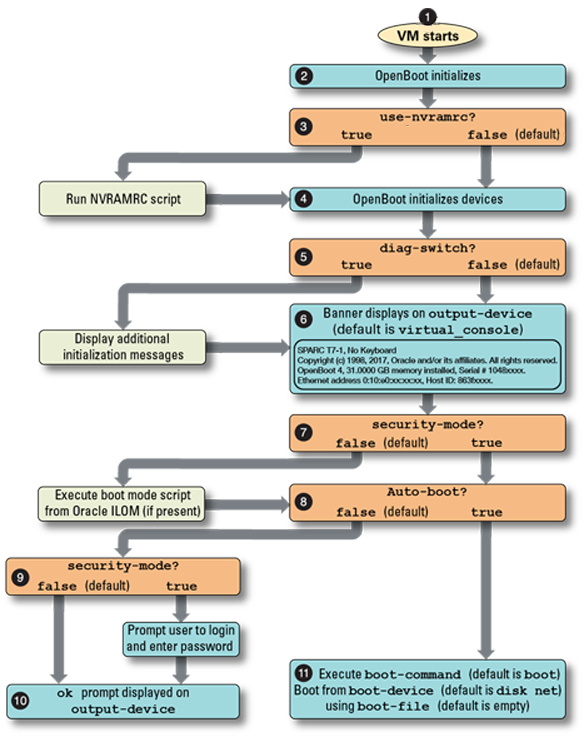Start-up Sequence
This flowchart provides a summary of a typical OpenBoot start-up sequence after a power-on or reset.

-
When the system or VM is started, OpenBoot is initialized.
-
Initialization – OpenBoot initializes its own data structures and those devices necessary for its own execution. The precise details of this initialization depend on the implementation and the computer system, but the these steps are often included (in no particular order):
-
Determine the memory configuration.
-
Select and prepare the memory to be used for FORTH and OpenBoot data structures like stacks, memory allocation pools, and device tree internal structures.
-
Initialize various devices (for example, MMUs, interrupt controllers, and timers) that are required for the basic functioning of FORTH and OpenBoot.
-
Reset the configuration variables contained therein to their default values.
-
-
The use-nvramrc? parameter is evaluated.
-
If true, a custom start-up script is executed (see Customizing Start-Up with NVRAMRC).
-
If false, OpenBoot does not seek to execute a custom start-up script.
-
-
Open boot runs probe-all to identify and initialize built-in and plug-in devices.
-
The diag-switch? parameter is evaluated.
-
If true, OpenBoot provides visibility into the PCIE probe sequence by displaying nodes as they are found. It also displays additional information about file system identification and the files that are loaded.
-
If false, OpenBoot does not display additional initialization messages.
-
-
The banner is displayed on the device specified for the output-device parameter. By default, the banner provides this information:
-
System type
-
OpenBoot version
-
Amount of installed memory
-
System serial number
-
Ethernet address
-
Host ID number
The banner can be manually displayed with the banner command. See Obtain Virtual machine Information with OpenBoot Commands.The banner can be customized. See Change the Power-On Banner
-
-
The security-mode? parameter is evaluated.
-
If false, OpenBoot checks to see if a boot mode script is specified in Oracle ILOM. If a boot mode script is found, OpenBoot executes the script.
-
If true, OpenBoot does not check for a boot mode script.
-
-
The auto-boot? parameter is evaluated.
-
If true, OpenBoot attempts to boot according to OpenBoot parameters.
Note - To enable automatic booting, the OpenBoot auto-boot? variable must be set to true and the Oracle ILOM auto-boot property must be enabled. -
If false, OpenBoot does not attempt to boot.
-
-
The security-mode? parameter is evaluated.
-
If false, OpenBoot does not prompt the user to login and provide a password.
-
If true, OpenBoot prompts the user to login and provide the password. See Setting Security Variables.
-
-
OpenBoot displays the ok prompt on the device specified for the output-device parameter.
-
OpenBoot attempts to boot according to the values specified for boot-command, boot-device, and boot-file. See Setting Configuration Variables.